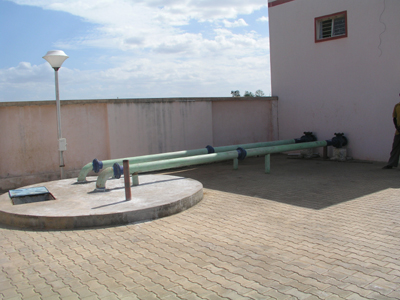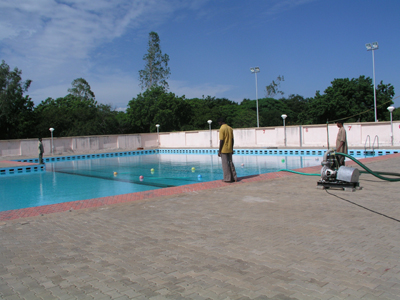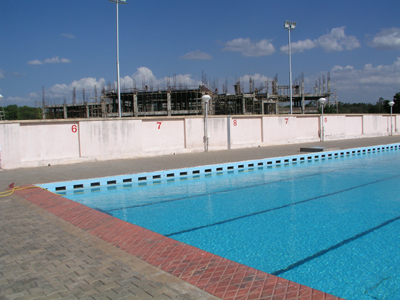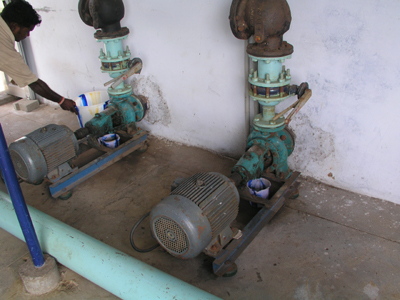The Swimming Pool
Our Institute is endowed with a beautiful swimming pool of 25 metre length. It caters to the students, faculty, and other residents of the campus.
The shallow pool for the tiny tots
The pool is maintained by a group of dedicated workers and managed by two coaches. All those who want to use the pool on regular basis must duly register themselves in the Office of the Physical Education Department. They must also strictly abide by the rules in force.
The swimming pool has three parts. There is a very shallow pool for the tiny tots. There is a wading pool for the learners. A deeper pool with a maximum depth of 8 feet is available for the more experienced swimmers and to those who train for competitions.
The 25m long deep pool
The wall separating the wading pool from the deep pool
The deep pool is separated from the wading pool for the learners by a net. Care should be taken by the learners not to slip into the deeper part of the pool.
Suction dredger
The accumulated dirt at the bottom of the pool is cleaned by using a suction dredger. A team of workers do the suction dredging daily to keep the pool clean. If dirt, which is mostly from the bodies of the swimmers, accumulates in the pool, it will accelerate the growth of algae in the pool. This spoils the water quality in the pool.
Another factor that accelerates algal growth is the presence of urea in the water. Urea salt gets into the water through unwashed sweat on the body and urine. That is why all the swimmers must thoroughly wash themselves with soap before entering into the pool. Remember, if you do not wash well before entering the pool, you are spoiling its water quality. Never relieve urine while swimming in the pool. It is not only a nutrient to the algal growth, it may also react with the chemical used to disinfect the water in the swimming pool. Also it is unhygienic.
Another source of nutrients for algal growth is the dust from foot wear. Therefore always leave the foot wears outside the pool premises and wash the feet inside the copper sulphate solution before getting inside the pool. A crystal clear pool is what we should always have. Just look at the picture and remember that we should always keep it that way.

Bathrooms and toilets
Make full use of the bathrooms and toilets to keep the pool in good condition. Also do not use soiled swimming costumes. The use of any clothing other than swimming costumes is strictly prohibited.
Cubicles to keep clothing
Cubicles are provided inside the bath rooms to keep your cloths. Never keep valuables inside them. The administration or the workers are not responsible for the valuables kept inside these cubicles.
The depth of the deep pool is marked on the perimeter wall
Pool worker cleaning the pool
When the swimmers are inside the pool, the workers have to look after their safety. Hence, the swimmers should obey them if the workers ask them to desist from doing something risky - like for example jumping into the deep pool.
Now let us see how our swimming pool works. The swimming pool contains roughly 5 lakh litres or 500 m3 of water. Keeping this amount of water in crystal clear condition is a very difficult task. For that we use filters and disinfecting chemicals. The 5 lakh litres of water is circulated through a filter once every ten hours with the use of a pump. Most of the solid particles get trapped in the filter. The filter is back-washed every two days to keep it clean.
To disinfect the pathogens in the water, metered quantities of sodium hypochlorite is added to the water when it is recirculated.
Sodium hypochlorite is applied in swimming pools for water disinfection and oxidation. It has the advantage that microorganisms cannot build up any resistance to it. Because sodium hypochlorite is used both to oxidize pollutants (urine, sweat, cosmetics) and to remove pathogenic microorganisms, the required concentration of sodium hypochlorite depends on the concentrations of these pollutants. Especially the amount of organic pollution - like sweat and urine - determines the required concentration. If the water is filtered before sodium hypochlorite is applied, less sodium hypochlorite is needed.
When sodium hypochlorite is used in swimming pools, it sometimes causes red eyes and it gives off a typical chlorine odor. When there is a lot of ureum (a mixture of urine and sweat) present, hypochlorous acid and ureum react to form chloramines. These chloramines irritate mucous membranes and cause the so-called ' chlorine smell'. In most swimming pools, these problems are prevented by water purification and ventilation. Eyes irritation disappears after a while. Now you know another reason why you must not enter the pool with sweat on your body and not urinate inside the pool while swimming.

Water is pumped to the filter after it is collected inside this well through the scum-gutters on the sides of the swimming pool.
The large filter inside the filter room
These two pumps recirculate the water through the filter. One runs continuously while the other is kept on standby. It takes ten hours to recirculate all the water in the swimming pool.
To know more about the swimming pool chemistry please click the link given below.
Click here for Swimming pool Chemistry
To know more about the swimming pool maintenance details please click the link given below.
Click here for Swimming pool Maintenance Details
Rules for Swimmers
Swimming Pool Timings
6:00 am to 8:30 am Ladies & Girl Students
3:00 pm to 6:30 pm Boys
6:30 pm to 8:00 pm Staff Members
1. Only registered members are allowed inside the swimming pool.
2. The registered members must surrender their identity cards when entering the pool and take it back when they are leaving the pool premises. No one will be allowed to swim in the swimming pool without surrendering their identity cards to the supervisor.
3. Sign in the register while leaving the swimming pool after collecting your identity card.
4. Presently the capacity of the pool is restricted to 40 members at any given time. Hence the members will be allowed in the pool on first-come-first-serve basis. This capacity may be increased in the future. The members should form a queue and get inside the pool in an orderly fashion.
5. Before entering the swimming pool all must take bath in the shower using soap to wash off the sweat, dirt and oil from the body. You must bring your own soap and towel.
6. Use the toilet before going to the pool. Do not urinate while swimming in the pool.
7. All must wear proper swimming costume and caps.
8. Walk along the blue line to reach the pool.
9. Wash off the dirt from the feet using copper sulphate solution kept in a trough.
10. Get into the pool only by steps/ladders.
11. Do not dive into the pool.
12. Avoid spitting or blowing the nose in the water, use the scum-gutter.
13. Practice swimming only in the areas instructed by the coach.
14. People suffering from skin diseases, open wounds, infection of ear, nose & eyes are prohibited from swimming in the pool.
15. Ladies should not use the swimming pool during the menstrual period.
16. Do not stay in the pool when there is lightning in the sky.
17. Enter the pool only after suitable warm up.
18. Those who do not know swimming must confine themselves to the shallow parts of the pool.
19. Do not play or cause nuisance to others in the pool. Users must not play pranks in the pool.
20. Do not swim with a full stomach of food.
21. Clear the pool when asked to vacate the pool when the supervisor whistles.
22. Since the swimming pool is being maintained by outside workers, all users (including staff members) must have valid identity card to use the swimming pool. Otherwise entry into the swimming pool will be denied.
23. No child below the age of 10 years will be allowed inside the swimming pool unaccompanied by its parents. The parents are solely responsible for the safety of such young children inside the pool premises.
24. Any suggestions for the improvement of the swimming pool can be sent to: Dean (Students), Associate Dean (Students).
SAFETY
Even though the pool may look perfectly safe, the swimmers are advised to exercise extreme caution while swimming.
The swimmers should not swim if they develop muscle cramps or feel faint. Users having heart problems must get medical opinion before swimming. Also, swimmers must do warm-up exercise before entering the pool.
If you find anybody struggling or sinking in the swimming pool, never jump into the water to save him/her.

Ring buoy
Instead, immediately throw one of the ring buoys available on the side of the swimming pool to the swimmer in distress. Then inform one of the life-guards on duty.













